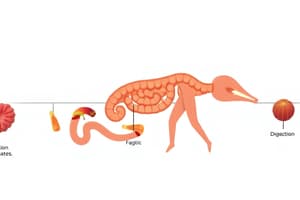Podcast
Questions and Answers
In a chemical reaction, what are located to the left of the arrow?
In a chemical reaction, what are located to the left of the arrow?
- Products
- Reactants (correct)
- Substrates
- Byproducts
Which of the following are sources of amino acids that plants use to make proteins?
Which of the following are sources of amino acids that plants use to make proteins?
- Atoms from glucose
- Amino acids from the ground (correct)
- Amino acids from animals
- Atoms from nitrogen compounds (correct)
What percentage of energy is typically transferred to the next trophic level?
What percentage of energy is typically transferred to the next trophic level?
- 10% (correct)
- 50%
- 0%
- 90%
To produce protein 1, which energy level requires the most energy?
To produce protein 1, which energy level requires the most energy?
How much energy would be consumed to create protein 3 if each bond requires 10 kcal?
How much energy would be consumed to create protein 3 if each bond requires 10 kcal?
What can be inferred if an organism is lacking canine teeth?
What can be inferred if an organism is lacking canine teeth?
Where does digestion begin in the body?
Where does digestion begin in the body?
Which statement is true regarding macromolecule consumption across organisms?
Which statement is true regarding macromolecule consumption across organisms?
In a food chain, what does an arrow represent?
In a food chain, what does an arrow represent?
What is the primary source of energy for elephants?
What is the primary source of energy for elephants?
Which type of bonds are most abundant in macromolecules with high energy content?
Which type of bonds are most abundant in macromolecules with high energy content?
Which organisms have the capability to fix nitrogen into a usable form?
Which organisms have the capability to fix nitrogen into a usable form?
What is the correct statement about enzymes?
What is the correct statement about enzymes?
Flashcards are hidden until you start studying
Study Notes
Digestion & Food Chains
- Digestion starts in the mouth.
- Energy is transferred through food chains.
- Arrows in food chains represent energy flow from one organism to another.
- Organisms use different macromolecules for energy, like carbohydrates for elephants and proteins for lions.
- Macromolecules containing more carbon-hydrogen bonds have the most energy.
Nutrition and Food Chemistry
- Herbivores have large molars for grinding plant matter.
- Carnivores have large canines for tearing meat.
- Enzymes are proteins that speed up chemical reactions.
- Lactase is an enzyme specifically for digesting lactose.
- Bonds are broken during digestion, releasing water and energy.
Building Organic Molecules
- Plants use nitrogen from the soil and glucose from photosynthesis to build proteins.
- Proteins are built from amino acids.
- About 10% of energy is transferred to the next trophic level in a food chain.
Energy in Chemical Reactions
- Reactants are on the left side of a chemical reaction's equation, while products are on the right side.
- Breaking bonds releases energy.
- Creating bonds requires energy.
Studying That Suits You
Use AI to generate personalized quizzes and flashcards to suit your learning preferences.




